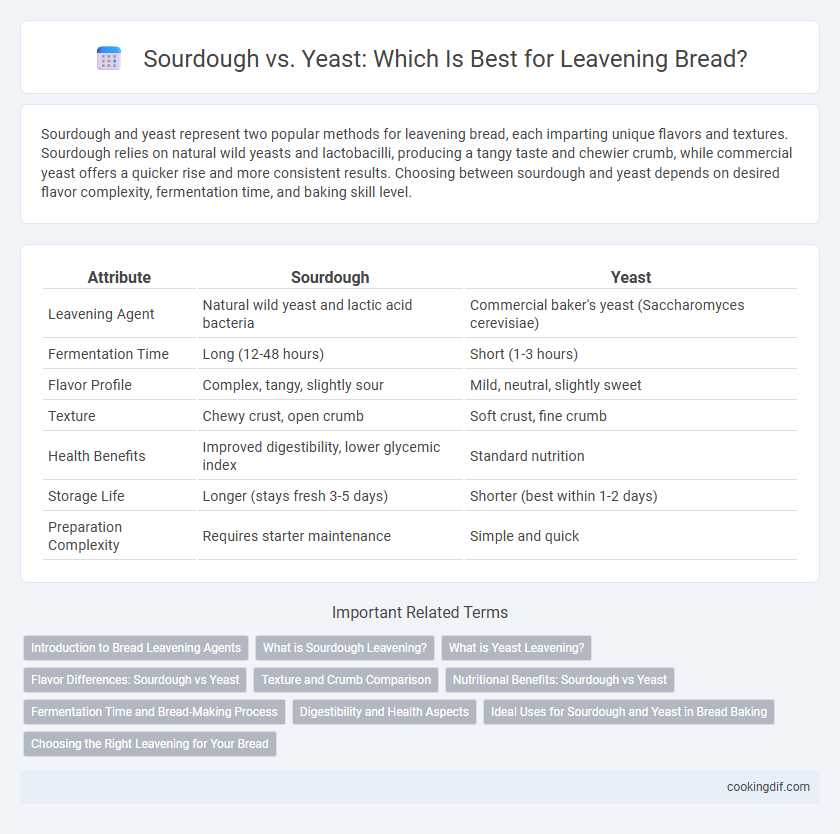Sourdough and yeast represent two popular methods for leavening bread, each imparting unique flavors and textures. Sourdough relies on natural wild yeasts and lactobacilli, producing a tangy taste and chewier crumb, while commercial yeast offers a quicker rise and more consistent results. Choosing between sourdough and yeast depends on desired flavor complexity, fermentation time, and baking skill level.
Table of Comparison
| Attribute | Sourdough | Yeast |
|---|---|---|
| Leavening Agent | Natural wild yeast and lactic acid bacteria | Commercial baker's yeast (Saccharomyces cerevisiae) |
| Fermentation Time | Long (12-48 hours) | Short (1-3 hours) |
| Flavor Profile | Complex, tangy, slightly sour | Mild, neutral, slightly sweet |
| Texture | Chewy crust, open crumb | Soft crust, fine crumb |
| Health Benefits | Improved digestibility, lower glycemic index | Standard nutrition |
| Storage Life | Longer (stays fresh 3-5 days) | Shorter (best within 1-2 days) |
| Preparation Complexity | Requires starter maintenance | Simple and quick |
Introduction to Bread Leavening Agents
Sourdough and yeast are the primary leavening agents used in bread making, each contributing unique characteristics to texture and flavor. Sourdough relies on naturally occurring wild yeasts and lactic acid bacteria, resulting in a tangy flavor and denser crumb. Commercial yeast, such as active dry or instant yeast, provides faster fermentation and consistent rise, producing lighter and airier bread.
What is Sourdough Leavening?
Sourdough leavening relies on a natural fermentation process using wild yeast and lactic acid bacteria present in a sourdough starter, which produces carbon dioxide to make bread rise. Unlike commercial yeast, sourdough fermentation develops complex flavors and improves the bread's texture and shelf life due to the organic acids generated. This method requires longer proofing times, enhancing digestibility and imparting a distinctive tangy taste.
What is Yeast Leavening?
Yeast leavening involves using live yeast cells that ferment sugars in the dough, producing carbon dioxide gas which causes the dough to rise and develop a light, airy texture. This process typically takes less time than sourdough fermentation, allowing for faster bread production with a mild flavor profile. Commercial baker's yeast, such as Saccharomyces cerevisiae, is commonly used for consistent and predictable leavening results in various types of bread.
Flavor Differences: Sourdough vs Yeast
Sourdough bread develops a complex, tangy flavor due to the natural fermentation of wild yeast and lactic acid bacteria, which produce organic acids and enhance the bread's depth. In contrast, yeast-leavened bread offers a milder, more neutral taste, as commercial yeast primarily ferments sugars without generating the same acidity or flavor complexity. The prolonged fermentation time in sourdough also intensifies the taste, resulting in a richer, more robust flavor profile compared to the relatively quick rise of yeast-leavened bread.
Texture and Crumb Comparison
Sourdough bread develops a denser, chewier texture with a more complex, open crumb structure due to natural fermentation by wild yeast and lactic acid bacteria. Yeast-leavened bread produces a softer, lighter texture with a uniform, airy crumb because of the faster carbon dioxide release from commercial yeast. The prolonged fermentation in sourdough enhances flavor depth and crust thickness, while yeast bread emphasizes tenderness and quicker rise times.
Nutritional Benefits: Sourdough vs Yeast
Sourdough bread offers enhanced nutritional benefits compared to yeast-leavened bread, including higher bioavailability of minerals such as magnesium, zinc, and iron due to the fermentation process that reduces phytic acid content. The natural fermentation involved in sourdough also increases the presence of probiotics and organic acids, which promote better gut health and improve digestion. In contrast, yeast-leavened bread lacks these fermentation-derived nutrients, resulting in a lower nutritional profile despite similar macronutrient content.
Fermentation Time and Bread-Making Process
Sourdough fermentation requires significantly longer time, often ranging from 12 to 48 hours, allowing natural wild yeast and lactobacilli to develop complex flavors and improve dough texture. Yeast leavening is much faster, typically taking 1 to 2 hours for proofing, which accelerates the bread-making process but results in a milder taste. The extended fermentation in sourdough enhances digestibility and shelf life, while yeast-based bread offers consistency and speed for commercial baking.
Digestibility and Health Aspects
Sourdough bread undergoes a natural fermentation process involving wild yeast and lactic acid bacteria, which breaks down gluten and lowers phytic acid content, enhancing digestibility and nutrient absorption. Yeast-leavened bread relies on commercial yeast, leading to shorter fermentation times and potentially higher levels of unfermented gluten, which may challenge those with gluten sensitivities. The probiotics and organic acids in sourdough improve gut health and stabilize blood sugar levels, making it a healthier option for individuals with digestive issues.
Ideal Uses for Sourdough and Yeast in Bread Baking
Sourdough thrives in artisan bread baking, producing complex flavors and a chewy texture perfect for rustic loaves and baguettes. Yeast excels in quick breads and soft sandwich loaves, delivering consistent rise and light, fluffy crumb. Bakers choose sourdough for extended fermentation and tangy depth, while yeast suits recipes requiring rapid proofing and mild taste.
Choosing the Right Leavening for Your Bread
Sourdough fermentation uses wild natural yeasts and lactic acid bacteria, which develop complex flavors and a chewy texture, ideal for artisanal bread. Commercial yeast offers faster fermentation, consistent rise, and better control over baking times, suitable for everyday bread-making. Selecting between sourdough and yeast depends on desired flavor profile, fermentation time, and baking convenience.
Sourdough vs Yeast for leavening Infographic

 cookingdif.com
cookingdif.com